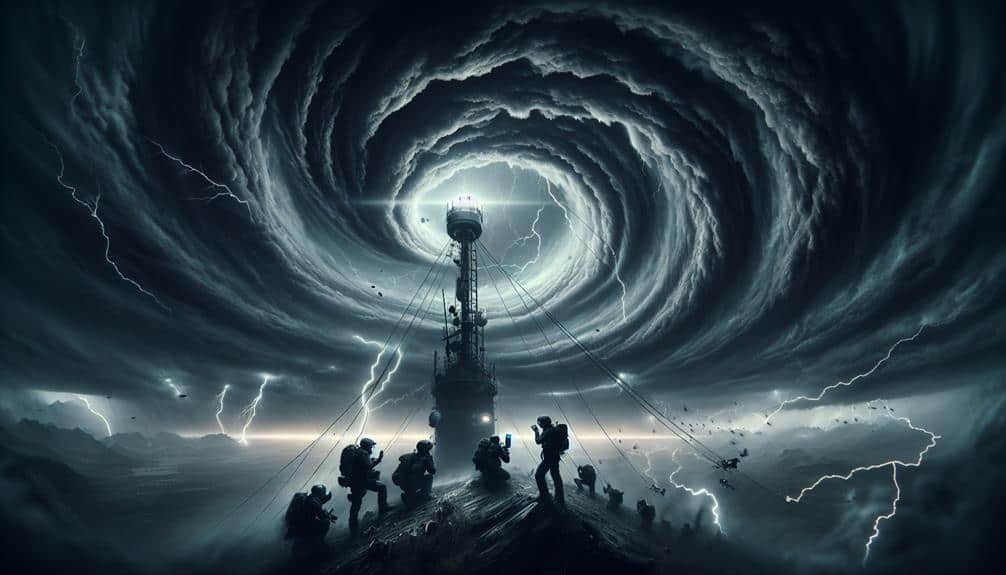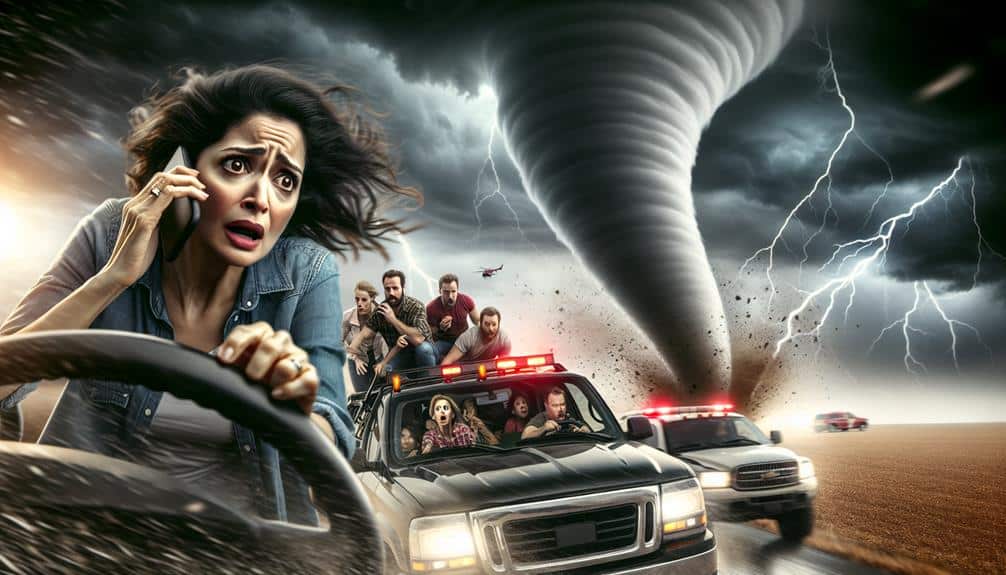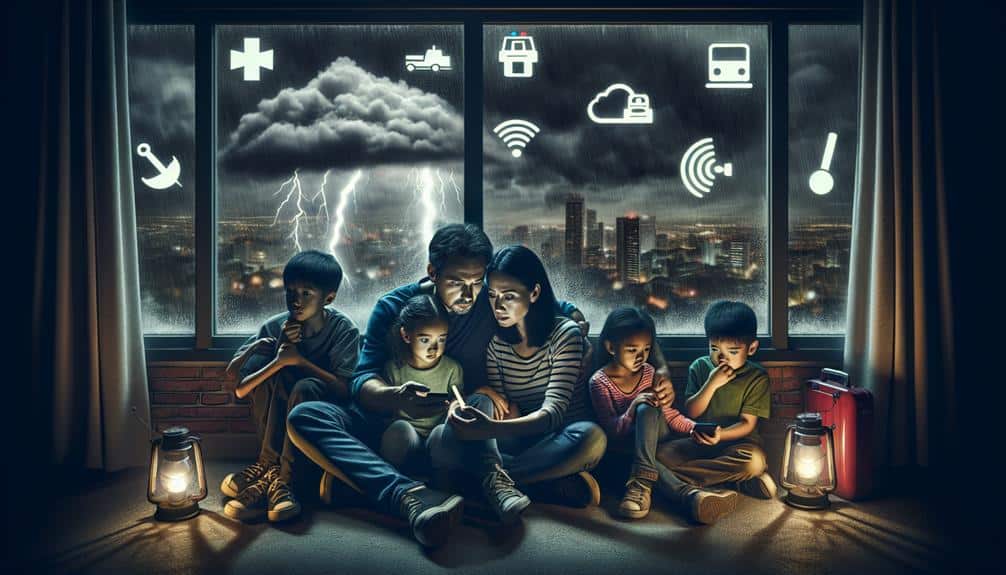In storm chasing, reliable communication is essential for safety and data exchange. We rely on satellite phones for their consistent signal in remote areas, while two-way radios provide clear, instant communication on specific VHF/UHF bands. Mobile apps offer real-time weather updates and radar imagery, improving our data collection capabilities. GPS trackers offer precise location tracking, and emergency beacons guarantee our signals break through environmental interferences. Additionally, social media platforms facilitate crowdsourced information, live streaming, automated alerts, and community support. By utilizing these tools, we're prepared to tackle severe weather with confidence. Explore further for a deeper understanding of these vital devices.
Key Points
- Satellite phones offer reliable communication and extensive coverage in remote areas during severe weather.
- Two-way radios provide instant, reliable communication over short distances using VHF and UHF bands.
- GPS trackers deliver real-time location updates and high-resolution mapping to ensure precise tracking.
- Emergency beacons transmit signals over vast distances, essential for search and rescue operations.
Satellite Phones
Satellite phones are essential for storm chasers, providing reliable communication when terrestrial networks fail. In the midst of severe weather, cell towers often become inoperative, leaving us without a lifeline. Satellite phones, with their superior signal reliability, guarantee that we stay connected no matter how remote or devastated the area. The extensive coverage areas offered by satellite networks, often spanning the entire globe, enable us to communicate from the most isolated locations.
From a technical perspective, satellite phones operate by connecting directly to satellites orbiting the Earth, bypassing terrestrial infrastructure entirely. This direct link guarantees a consistent signal, vital for receiving real-time weather updates and coordinating with emergency contacts. Cost efficiency is another significant factor. While initial investments and airtime can be pricey, the value of uninterrupted communication in life-threatening situations is immeasurable. For instance, emergency calls made via satellite phone can expedite rescue missions, potentially saving lives.
Moreover, the ability to maintain contact with our team members and emergency services during a storm gives us the freedom to pursue our passion safely. To sum up, satellite phones are an essential tool, blending advanced technology with practical benefits, ensuring our safety and success in storm chasing missions.
Two-Way Radios
While satellite phones guarantee global connectivity, two-way radios provide us with instant, reliable communication over short distances, which is critical for real-time coordination among team members during storm chases. Leveraging specific radio frequencies guarantees our conversations remain clear and uninterrupted, a necessity when maneuvering through volatile weather conditions.
Two-way radios operate on both VHF (Very High Frequency) and UHF (Ultra High Frequency) bands. VHF is ideal for open areas, offering extended range, whereas UHF excels in urban settings where obstacles like buildings may interfere with signals. Using these frequencies, we can maintain seamless communication, even when mobile networks fail.
Moreover, two-way radios offer additional features tailored for storm chasers:
- NOAA Weather Updates: Access to National Oceanic and Atmospheric Administration channels for real-time weather alerts.
- Emergency Channels: Pre-programmed frequencies dedicated to emergency communication.
- Durability: Built to withstand harsh weather conditions, including rain, wind, and extreme temperatures.
Mobile Apps
In addition to our physical tools, mobile apps have transformed how we collect and analyze meteorological data on the go. These apps provide real-time updates on weather patterns, enabling us to make informed decisions quickly. With data pulled from various meteorological databases, we can access detailed radar imagery, storm tracks, and predictive models directly from our smartphones.
However, we must be mindful of data usage and privacy concerns. Many of these apps require constant internet connectivity and access to our location, which can consume significant amounts of data. It's important to select apps that offer robust privacy policies and allow us to control how our data is used and shared.
The user interface and accessibility features of these apps are also essential. A well-designed user interface ensures that we can navigate the app efficiently, even in high-stress situations. Features such as voice commands, high-contrast modes, and customizable alerts enhance our ability to stay informed and react promptly.
Apps like RadarScope and Storm Shield are excellent examples, offering intuitive interfaces and necessary accessibility options.
GPS Trackers
Tracking our exact location becomes essential during storm chasing, and GPS trackers provide the precision and reliability we need in the field. These devices use satellites to pinpoint our position with remarkable data accuracy, ensuring we're always aware of our location relative to the storm. High signal strength is vital, especially in remote areas where cellular networks may fail.
With GPS trackers, we benefit from:
- Real-time location updates: These allow for immediate adjustments to our route, optimizing tracking efficiency and keeping us in the safest possible position.
- High-resolution mapping: This feature provides detailed maps, enabling us to navigate challenging terrains with confidence and precision.
- Data logging: Thorough records of our routes and locations can be crucial for post-chase analysis and improving future strategies.
Utilizing GPS trackers not only boosts our operational efficiency but also greatly enhances our safety. By leveraging advanced technology, we maintain the freedom to chase storms effectively, without compromising on reliability or accuracy.
Emergency Beacons

When evaluating emergency beacons, we must consider signal range capabilities, guaranteeing reliable communication over extensive distances.
Battery life longevity is vital, with data showing that beacons with extended operational periods greatly enhance safety.
Additionally, their durability in harsh conditions, like strong winds and heavy rain, ensures they remain functional when we need them most.
Signal Range Capabilities
Emergency beacons' signal range capabilities are crucial for storm chasers, as they directly impact the effectiveness of search and rescue operations in remote areas. When navigating through extreme weather patterns, it's vital our communication methods are reliable and far-reaching. The ability to transmit signals over vast distances can mean the difference between life and death.
Understanding signal range capabilities involves several key factors:
- Frequency Bands: Utilizing high-frequency bands can extend the signal range, guaranteeing that distress signals are picked up by satellites or ground stations even in adverse conditions.
- Antenna Design: Advanced antenna designs, such as those with higher gain and directional capabilities, greatly enhance the beacon's range and clarity of transmission.
- Environmental Interference: Weather patterns, like heavy rain or snow, can weaken signals. Beacons designed to counteract these interferences maintain better transmission quality.
Battery Life Longevity
Battery lifespan in emergency beacons is a critical factor that ensures continuous operation during prolonged storm chasing expeditions. We rely on advanced power management systems to significantly prolong the functionality of our beacons. These systems optimize energy consumption, balancing performance with power conservation. By incorporating intelligent power management, we can extend the operational life of our devices to a great extent.
Charging solutions also play a pivotal role in maintaining battery lifespan. We use a combination of rapid charging technologies and portable battery backup units to keep our devices powered up. These backup units are essential, providing an immediate power source when primary batteries deplete.
Additionally, integrating solar panels into our equipment setup offers sustainable charging solutions. These panels harness solar energy, converting it into electrical power to recharge our beacons. This renewable energy source is invaluable, especially during extended field operations when traditional power sources are unavailable.
Durability in Conditions
Our emergency beacons must endure the most extreme conditions, from torrential downpours to intense heat, guaranteeing they remain operational when we need them most. Durability in conditions is non-negotiable for us storm chasers, as our lives may depend on these devices.
First, waterproof technology is critical. Beacons must have an IP67 or higher rating, ensuring they can withstand submersion in water up to one meter for 30 minutes. This level of protection is crucial when moving through flooded areas or during heavy rains.
Second, impact resistance is another key factor. Emergency beacons should meet MIL-STD-810G standards, which test for resistance to shock, vibration, and drops. This ensures the beacons endure rough handling and accidental drops, maintaining functionality even in chaotic environments.
To break down the essential features:
- Waterproof technology: IP67 or higher rating.
- Impact resistance: MIL-STD-810G standard compliance.
- Temperature tolerance: Operability in a range from -20°C to 60°C.
Social Media Platforms
We can't underestimate the utility of social media platforms for storm chasers, as they offer real-time updates and essential situational awareness.
With community support, we can share data, observations, and receive immediate feedback.
Integrated alert systems enhance our ability to respond swiftly to emergent weather threats, in addition.
Real-time Updates
In today's fast-paced storm chasing landscape, real-time updates from social media platforms like Twitter and Facebook provide essential, up-to-the-second data necessary for making informed decisions in the field. These platforms enhance our weather tracking and emergency response capabilities by delivering high-frequency updates directly from meteorologists, storm chasers, and automated weather systems. The immediacy of this data greatly boosts communication reliability and data accuracy, vital for our safety and operational efficiency.
Real-time social media updates offer several advantages:
- Crowdsourced Information: We gain access to a multitude of observations and reports from other storm chasers and local residents, enriching our situational awareness.
- Live Streaming: Platforms like Facebook Live enable us to broadcast our observations in real time, facilitating instant sharing and collaboration.
- Automated Alerts: Twitter bots and specialized accounts provide automated updates on severe weather conditions, ensuring we never miss crucial warnings.
Community Support
Often, the storm chasing community utilizes social media platforms to cultivate collaboration and support, sharing priceless insights and resources that improve both preparedness and response strategies. Platforms like Twitter, Facebook, and Instagram serve as essential hubs where meteorologists, storm chasers, and concerned citizens come together to exchange real-time data, weather alerts, and safety recommendations.
By engaging in these online forums, we can quickly spread information about upcoming volunteer opportunities and fundraising campaigns aimed at strengthening disaster relief efforts. These platforms help us mobilize resources and manpower efficiently, ensuring timely assistance to affected regions. Additionally, social media facilitates the formation of local partnerships with emergency services, community leaders, and NGOs, thereby enhancing our collective response capacity.
Furthermore, we regularly utilize these networks to promote disaster preparedness workshops, which are vital for educating the public on emergency protocols and safety measures. By sharing expert knowledge and scientific terminology through accessible content, we empower individuals to take proactive steps in safeguarding their lives and property.
Essentially, social media not only provides a channel for immediate communication but also nurtures a resilient and informed storm-chasing community, ready to confront any meteorological challenge.
Alert Systems
Social media platforms serve as indispensable alert systems, enabling rapid dissemination of real-time weather warnings and critical updates to the storm-chasing community. By leveraging these tools, we can optimize our weather monitoring capabilities and streamline communication protocols. Platforms such as Twitter, Facebook, and Instagram are particularly effective due to their vast user bases and instantaneous information-sharing features.
Utilizing these platforms allows us to stay ahead of severe weather events, ensuring we can take timely and informed actions. Here are four essential ways social media enhances our alert systems:
- Crowdsourced Data: Users often share real-time observations, pictures, and videos, contributing to a more thorough understanding of storm conditions.
- Automated Alerts: Many weather agencies use social media APIs to push automated weather alerts directly to users, enhancing situational awareness.
- Live Streaming: Platforms like Facebook Live and Instagram Live enable storm chasers to broadcast conditions in real-time, offering immediate and visual updates.
Frequently Asked Questions
How Can Storm Chasers Stay Updated on Changing Weather Conditions in Real-Time?
We can stay updated on changing weather conditions in real-time by leveraging satellite technology for precise data and using weather radios for continuous updates. These tools give us the freedom to track and respond to atmospheric changes effectively.
What Safety Gear Should Storm Chasers Always Carry With Them?
Well, we can't just rely on luck, can we? For emergency preparedness, storm chasers should always carry essential gear like helmets, first aid kits, NOAA weather radios, and multi-tools. It's all about maximizing our safety and freedom.
Are There Any Specific Training Programs for Aspiring Storm Chasers?
There are specific training programs offering certification for aspiring storm chasers. These programs combine field experience and mentorship, ensuring we gain practical skills and scientific knowledge. Data-driven coursework prepares us for real-world storm chasing scenarios.
How Do Storm Chasers Coordinate With Local Emergency Services During a Storm?
We coordinate with local emergency services using established emergency protocols and advanced communication tools. Our strategies include real-time data sharing and predefined coordination methods to guarantee timely, accurate information flow, enhancing overall safety and operational efficiency during storms.
What Are the Legal Requirements for Storm Chasing in Different Regions?
We must understand the legal requirements and safety protocols for storm chasing, which vary by region. Some areas require permits, while others impose strict safety guidelines. Adhering to these guidelines ensures both our safety and the freedom to chase responsibly.


